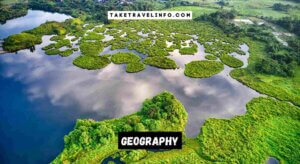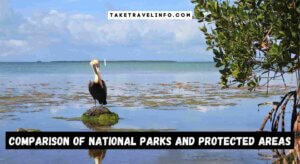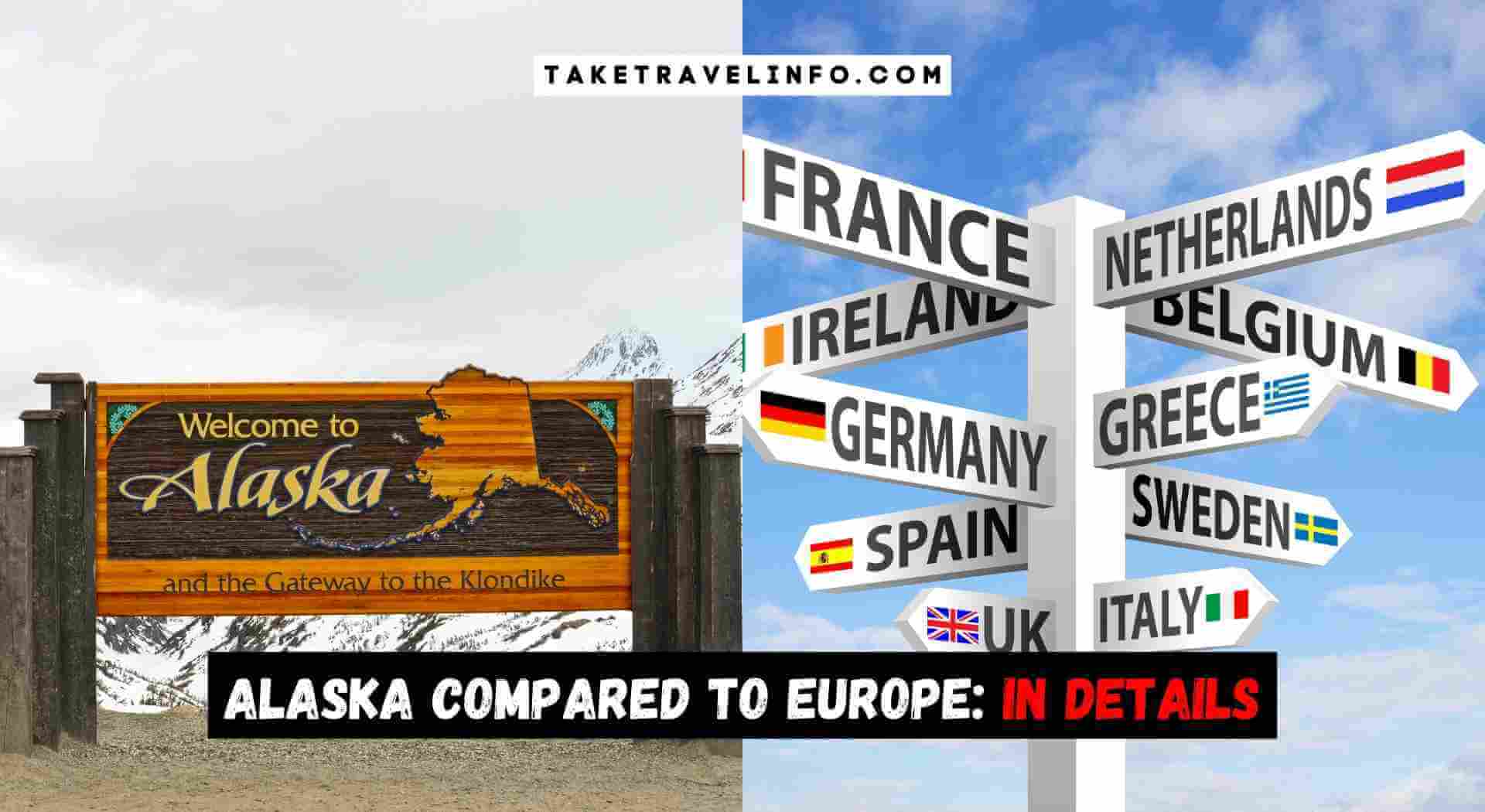Alaska and Europe are contrasting in terms of geography, climate, and cultural diversity. Alaska is a vast state in North America, known for its stunning natural landscapes, including glaciers and mountains.
In contrast, Europe is a continent consisting of various countries with diverse cultures, architecture, and historical landmarks. From the snowy wilderness of Alaska to the bustling cities and rich histories of Europe, these two regions offer unique experiences for travelers.
Whether you seek adventure in the untamed wilderness or want to immerse yourself in the art and culture of historic cities, both Alaska and Europe have something special to offer. Explore the extremes of natural beauty in Alaska or discover the rich cultural heritage of Europe, and embark on a journey that will leave you with unforgettable memories.
Alaska Compared To Europe: Geography

Alaska and Europe, are two vastly different regions that boast unique geographical features and climates. Let’s dive into the distinctive aspects of their geography and explore how these factors shape their environments.
Comparison Of Land Area
To begin, let’s examine the land area of Alaska and Europe:
- Alaska covers a massive land area of approximately 1.7 million square kilometers.
- Europe, on the other hand, spans over 10 million square kilometers, making it significantly larger than Alaska.
Mention Of Geographical Features In Alaska And Europe
Moving on, both Alaska and Europe showcase captivating geographical features:
Alaska:
- Home to the majestic Denali, North America’s highest peak, and impressive mountain ranges like the Brooks Range and the Alaska Range.
- Vast stretches of wilderness, including extensive forests, glaciers, and more than 3 million stunning lakes.
- A unique coastline with fjords, bays, and numerous islands, offering splendid views of the pacific ocean and the Gulf of Alaska.
Europe:
- A diverse landscape encompasses enchanting mountain ranges such as the Alps and the Pyrenees, attracting avid hikers and mountaineers.
- The picturesque Mediterranean coastline, with its tranquil beaches, azure waters, and charming coastal towns.
- The vast fertile plains of Europe, such as the expansive north European plain and the Pannonian basin.
Discussion On Climate Differences
One of the most notable differences between Alaska and Europe lies in their climates:
Alaska:
- Experiences a subarctic and arctic climate, characterized by long, cold winters and short, mild summers.
- Inland areas tend to have extreme temperature fluctuations, with temperatures dropping as low as minus 40 degrees Celsius during winter.
- Coastal regions benefit from the moderating influence of ocean currents, leading to milder temperatures compared to the interior.
Europe:
- Possesses a wide range of climates, including Mediterranean, continental, oceanic, and subarctic climates.
- The Mediterranean region enjoys hot, dry summers and mild, wet winters.
- Continental Europe experiences distinct seasons, with cold winters and warm summers.
Alaska and Europe differ greatly in terms of land area, geographical features, and climate. From Alaska’s vast wilderness and impressive mountain ranges to Europe’s diverse landscapes and varied climates, both regions offer their distinct beauty and allure to explorers and nature enthusiasts.
Wildlife And Nature

Alaska and Europe boast an array of unique wildlife that captivates nature enthusiasts from around the globe. As you explore these vast regions, you’ll encounter fascinating creatures and experience the wonders of the natural world. Let’s delve into the distinct wildlife found in Alaska and Europe:
Alaska’S Wildlife:
- Grizzly bears: Towering and powerful, grizzly bears are a common sight in Alaska. Their massive presence fills the wilderness with a sense of awe and respect.
- Bald eagles: As America’s national symbol, bald eagles soar through the Alaskan skies, showcasing their elegant wingspan and majestic beauty.
- Moose: Alaska’s largest terrestrial mammal, the moose, roams freely through dense forests and wetlands, enchanting visitors with its towering antlers and unique splendor.
- Humpback whales: The icy waters of Alaska are home to mesmerizing humpback whales. Witness their magnificent breaches and tail flukes as they navigate the sea.
Europe’S Wildlife:
- Brown bears: Europe boasts an abundant population of brown bears. These magnificent creatures can be found in several countries, including Romania, Finland, and Spain.
- Red deer: With their striking coats and impressive antlers, red deer inhabit forests throughout Europe. Observing their elegant movements during mating season is a truly captivating experience.
- Ibex: Scaling the steep slopes of the European Alps, ibex exhibit exceptional agility and grace. These mountain goats showcase their sturdy horns and dexterity in challenging terrains.
- Eurasian lynx: Europe’s largest feline predator, the Eurasian lynx, roams the wilderness with stealth and precision. Intriguing and elusive, spotting this beautiful carnivore is a rare treat.
Comparison Of National Parks And Protected Areas

Both Alaska and Europe are proud to preserve vast areas of natural beauty through national parks and protected areas. Here are some highlights of these protected regions in both destinations:
Alaska’S National Parks And Protected Areas:
- Denali national park and Preserve: Boasting the tallest peak in North America, Denali national park and Preserve offers pristine wilderness, featuring diverse wildlife and breathtaking views.
- Katmai national park and Preserve: Famous for its population of grizzly bears, katmai national park and Preserve also showcase the stunning valley of ten thousand smokes, a testament to its volcanic history.
- Kenai fjords national park: Witness the awe-inspiring hardening icefield, calving glaciers, and abundant marine life in Kenai fjords national park. This icy wonderland leaves visitors in awe.
Europe’S National Parks And Protected Areas:
- Plitvice lakes national park, Croatia: Crystal-clear turquoise lakes interconnected by cascading waterfalls make Plitvice lakes national park a picturesque destination straight out of a fairy tale.
- Sarek national park, Sweden: With its remote and untamed wilderness, sarek national park showcases untamed beauty, towering mountains, ancient forests, and the iconic Kungsleden hiking trail.
- Cinque Terre national park, Italy: The colorful villages nestled along the rugged Ligurian coastline make cinque terre national park a unique and visually stunning destination.
Outdoor Activities And Eco-Tourism Opportunities

Both Alaska and Europe provide exceptional opportunities for outdoor enthusiasts and eco-tourism enthusiasts alike. Here’s a glimpse of what awaits those seeking adventure and sustainable travel experiences:
Alaska’S Outdoor Activities And Eco-Tourism:
- Dog sledding in the Alaskan wilderness: Experience the thrill of gliding over the snow-covered landscape, guided by a team of spirited sled dogs.
- Salmon fishing: Cast your line in the pristine rivers and streams of Alaska and engage in one of the world’s most renowned salmon fishing experiences.
- Glacier trekking: Embark on a guided glacier trek and explore the mesmerizing ice formations and blue-hued landscapes that Alaska’s glaciers offer.
Europe’S Outdoor Activities And Eco-Tourism:
- Hiking in the swiss alps: Traverse spectacular alpine trails, passing through charming villages, lush meadows, and panoramic mountain vistas.
- Bicycle touring in the Netherlands: Pedal along well-planned cycling routes, immersing yourself in the stunning landscapes and vibrant culture of the Netherlands.
- Birdwatching in the Danube Delta: Discover the diverse avian species in the expansive wetlands of the Danube Delta, a haven for birdwatching enthusiasts.
Both Alaska and Europe offer a tapestry of breathtaking wildlife, protected natural areas, and thrilling outdoor activities. Whether you yearn for close encounters with grizzly bears in Alaska or dream of hiking amidst the scenic beauty of the European Alps, these destinations never fail to leave a lasting impression.
As you venture forth, be prepared to be swept away by the wonders of wildlife and nature that await you.
Culture And History
Alaska and Europe boast rich cultural and historical backgrounds that captivate the imaginations of travelers. From the exploration of indigenous cultures to the comparison of historical landmarks and heritage sites, these regions offer a diverse tapestry of traditions and stories.
Additionally, traditional arts, music, and festivals form an integral part of both Alaskan and European cultures. Let’s delve into these aspects further:
Exploration Of Indigenous Cultures In Alaska And Europe
In Alaska:
- Native Alaskan tribes, such as the Inuit, Yupik, and Tlingit, have a deep-rooted connection to the land, embracing traditional lifestyles and customs.
- Indigenous artwork, like intricate carvings and totem poles, provides a glimpse into the rich cultural heritage of Alaska’s native communities.
- Storytelling, dance, and ceremonies serve as important means of passing down oral history and traditions.
In Europe:
- Europe is home to various indigenous cultures, including the same people in the Nordic countries, the Basque people in Spain, and the Saami in Russia.
- These cultures showcase their heritage through vibrant folk costumes, unique art forms, and traditional rituals.
- Folklore and mythology play a significant role in preserving and celebrating the indigenous cultures of Europe.
Comparison Of Historical Landmarks And Heritage Sites
In Alaska:
- The klondike gold rush national historical park in Skagway tells the tale of the famous gold rush, allowing visitors to step back in time and experience the life of prospectors.
- Totem bight state historical park in Ketchikan showcases an impressive collection of totem poles, illustrating the artistic and symbolic traditions of Alaskan native peoples.
- The Russian bishop’s House in Sitka provides an insight into Alaska’s Russian history and the influence of Russian Orthodox culture.
In Europe:
- The Acropolis of Athens in Greece stands as a symbol of ancient Greek civilization, housing iconic structures like the Parthenon.
- The Colosseum in Rome, Italy, is an awe-inspiring amphitheater that represents the grandeur of the roman empire.
- Notre-dame Cathedral in Paris, France, is a prime example of Gothic architecture and holds immense historical and cultural significance.
Discussion On Traditional Arts, Music, And Festivals
In Alaska:
- Native Alaskan art encompasses various mediums, including basketry, beadwork, and traditional Alutiiq dance masks, beautifully depicting stories and legends.
- The Athabascan fiddle festival celebrates the folk music of Alaska’s indigenous Athabascan people, featuring lively performances and captivating melodies.
In Europe:
- Traditional arts in Europe vary widely, from intricate Celtic knotwork in Ireland to delicate porcelain craftsmanship in Meissen, Germany.
- European musical traditions span across genres, including flamenco in Spain, classical compositions from great composers like Mozart and Beethoven, and the infectious melodies of traditional Irish music.
- Festivals like Oktoberfest in Germany, carnival in Venice, and St. Patrick’s Day in Ireland offer a delightful blend of cultural celebrations, highlighting unique traditions and cuisines.
Immerse yourself in the captivating cultural heritage and mesmerizing history that both Alaska and Europe offer. Whether exploring vibrant indigenous cultures, admiring historical landmarks, or reveling in traditional arts and music, these regions will undoubtedly leave a lasting impression.
Frequently Asked Questions Of Alaska Compared To Europe
How Does The Size Of Alaska Compare To Europe?
Alaska is the largest state in the united states, covering approximately 1. 7 million square kilometers. In comparison, Europe is much larger, spanning over 10 million square kilometers. Europe is made up of multiple countries, each with its own distinct cultures, languages, and landscapes.
What Is The Population Difference Between Alaska And Europe?
Alaska has a relatively small population, with around 731,000 residents. On the other hand, Europe is home to over 741 million people, making it the third most populous continent in the world. The population density in Europe is significantly higher compared to Alaska.
How Do The Climates Of Alaska And Europe Differ?
Alaska and Europe experience different climates due to their geographical locations. Alaska has a subarctic climate, characterized by long, cold winters and relatively mild summers. Europe, on the other hand, has a diverse range of climates, including Mediterranean, temperate, and continental climates, depending on the region.
What Are The Main Geographical Features Of Alaska And Europe?
Alaska is known for its rugged and diverse geography, including towering mountains, vast forests, and icy glaciers. In contrast, Europe showcases a variety of geographical features such as the Alps mountain range, the Scandinavian fjords, and the vast European plains.
How Does Tourism In Alaska Compare To Europe?
Alaska and Europe both attract large numbers of tourists each year, but they offer different experiences. Alaska is known for its pristine wilderness, wildlife watching, and outdoor adventures such as glacier hiking and whale watching. Europe, on the other hand, offers a rich cultural heritage, historical sites, stunning architecture, and a wide range of cuisines to explore.
Conclusion
Alaska and Europe are two vastly different places with their unique charms and characteristics. While Alaska boasts breathtaking natural wonders such as glaciers and wildlife, Europe offers a rich history, diverse cultures, and iconic landmarks. Each destination provides unforgettable experiences, and the choice ultimately depends on personal preferences and desired experiences.
Whether you seek adventure and solitude in the untamed wilderness of Alaska or cultural immersion and historical exploration in the cities of Europe, both options will leave you amazed and yearning for more. So, whether you’re a nature enthusiast or a history buff, both Alaska and Europe offer endless possibilities for exploration and discovery.
Whichever destination you choose, you’re bound to create memories that will last a lifetime.

